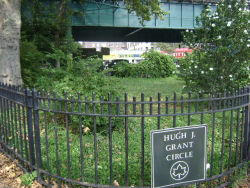Hugh J. Grant Circle
Hugh J. Grant Circle
What was here before?
This site was once a tract of farmland owned by the Pugsley family in the early 19th century. The land became part of the Cobb and Larkin family farms in the late 1800s, until the City acquired it incrementally in the first decade of the 20th century.
A few blocks from this site is Parkchester, one of the first large-scale housing developments in America. It was built on the site of the New York Catholic Protectory, a trade school for “wayward boys” opened by the Christian Brothers after the Civil War, which operated here until construction of the housing development began in 1938.
How did this site become a park?
The City acquired the land for Hugh J. Grant Circle on May 2, 1904 through condemnation procedures. In the center of the park is the Parkchester station on the MTA’s 6 train line which opened in 1920. It was gradually renovated in conjunction with the Cross-Bronx Expressway and incorporated into long-term plans for the neighborhood’s development. The park reopened on July 21, 1956.
Along with neighboring Virginia Park, Hugh J. Grant Circle was completely reconstructed in 2021 as part of NYC Parks’ Parks Without Borders initiative to make the area a more open, accessible, and seamless part of the community. The project redesigned the park’s entrances and provided new paving and fences to redefine this public space. Additional features like benches, drinking fountains, and plantings were added, to enhance the overall appearance of the site. Park security lighting will further activate the public area, providing a safer, more welcoming passage. Today the park remains a green oasis in the midst of several major thoroughfares.
Who is this park named for?
This park was named after former New York City Mayor Hugh J. Grant (1857-1910) on December 5, 1911 by the Board of Aldermen. Inaugurated at only 31 years of age, Grant is New York City's youngest mayor. A native New Yorker, Grant was educated in Catholic schools in the United States and Berlin before attending Columbia University Law School. His father owned several taverns on Manhattan’s Upper West Side and helped Grant make connections with local Irish American organizations who aided his political career. Backed by Tammany Hall, Grant became an Alderman in 1882, sheriff of New York in 1885, and finally mayor in 1889.
A one-term mayor, Grant favored limited government and is known for his opposition to the state’s intervention in city business, an issue that led him to oppose the acquisition of Pelham Bay and Van Cortlandt Parks. He believed the parks were too expensive to acquire and develop and too inaccessible for most New York City residents to justify their purchase. Though Grant was against the acquisition of these parks, he nonetheless had a park named after him in the same borough.
Check out your park's Vital Signs
Clean & Safe
Green & Resilient
Empowered & Engaged Users
Share your feedback or learn more about how this park is part of a
Vital Park System





